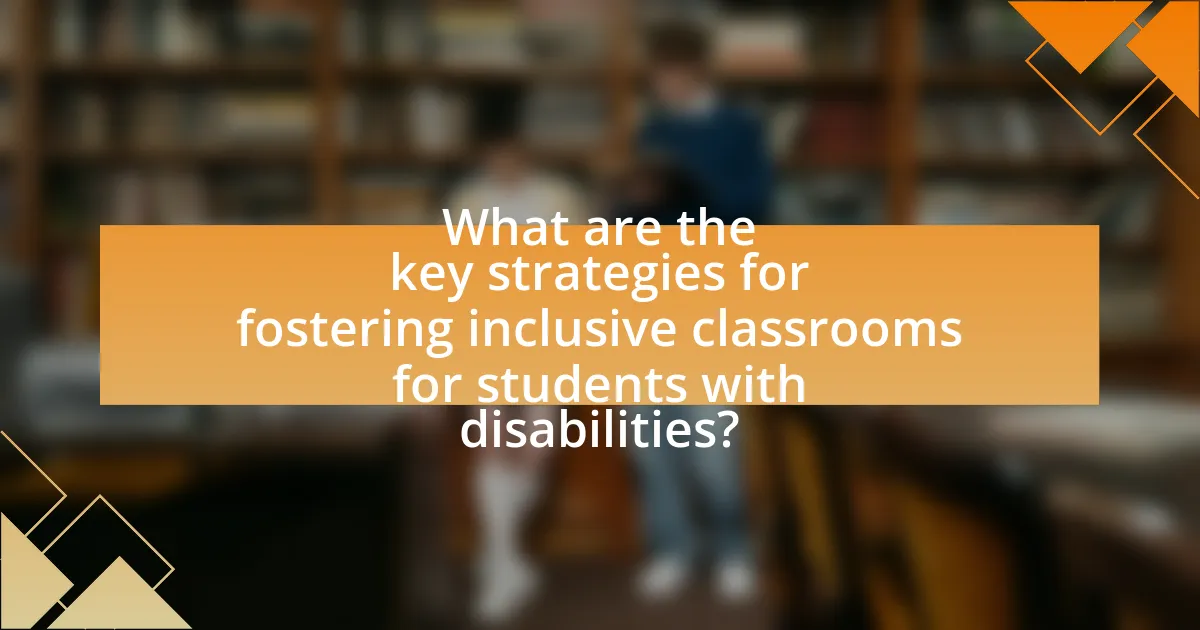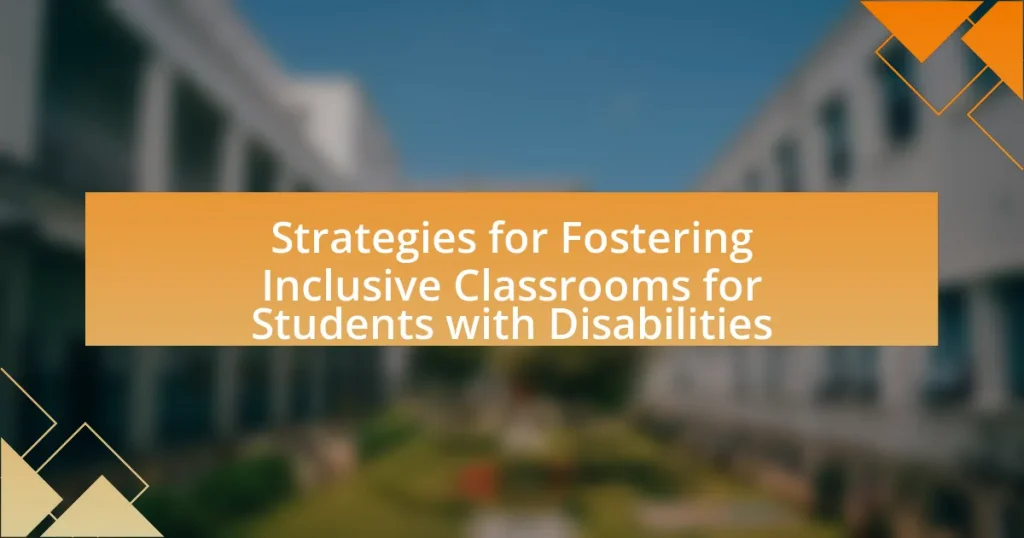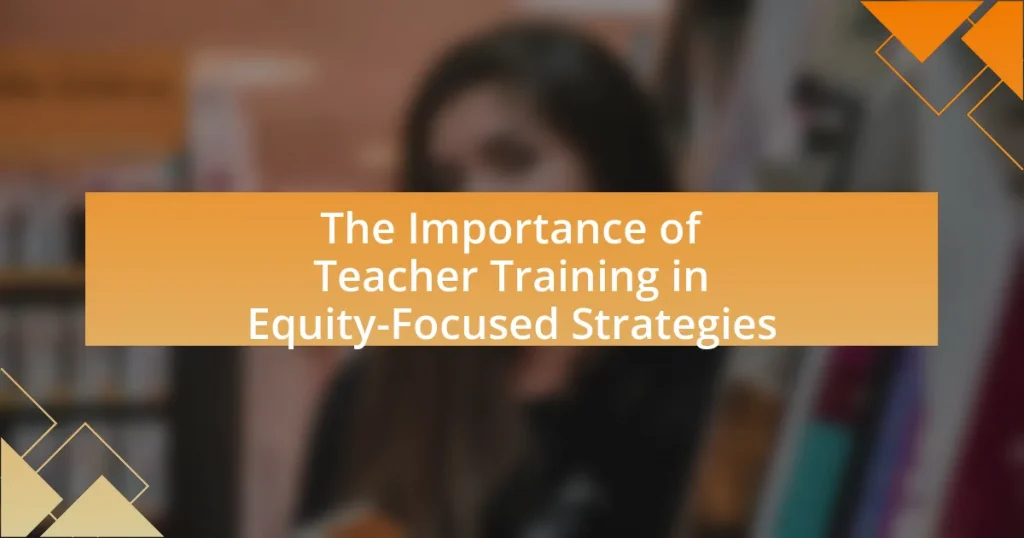The article focuses on strategies for fostering inclusive classrooms for students with disabilities, emphasizing key approaches such as differentiated instruction, collaborative learning, and the use of assistive technology. It outlines how teachers can create welcoming environments, promote positive interactions, and implement effective instructional strategies to support diverse learning needs. Additionally, the article discusses the importance of classroom layout, family collaboration, and ongoing professional development for educators, as well as methods for assessing the effectiveness of inclusive practices. By highlighting research findings, the article provides a comprehensive overview of best practices that enhance academic outcomes and social integration for students with disabilities.

What are the key strategies for fostering inclusive classrooms for students with disabilities?
Key strategies for fostering inclusive classrooms for students with disabilities include differentiated instruction, collaborative learning, and the use of assistive technology. Differentiated instruction allows teachers to tailor lessons to meet diverse learning needs, ensuring that all students can engage with the material effectively. Collaborative learning promotes peer interactions, which can enhance social skills and provide support among students. The integration of assistive technology, such as speech-to-text software or specialized learning apps, further enables students with disabilities to access the curriculum and participate fully in classroom activities. Research indicates that these strategies lead to improved academic outcomes and social integration for students with disabilities, as highlighted in studies by the National Center for Learning Disabilities.
How can teachers create a welcoming environment for all students?
Teachers can create a welcoming environment for all students by implementing inclusive practices that recognize and celebrate diversity. This includes using varied teaching methods to accommodate different learning styles, fostering open communication, and encouraging collaboration among students. Research indicates that classrooms that promote inclusivity lead to improved academic outcomes and social interactions, as evidenced by a study published in the Journal of Special Education, which found that inclusive classrooms enhance peer relationships and reduce stigma for students with disabilities.
What role does classroom layout play in inclusivity?
Classroom layout significantly influences inclusivity by facilitating access and engagement for all students, particularly those with disabilities. An inclusive classroom layout incorporates flexible seating arrangements, clear pathways, and designated areas for various activities, which accommodate diverse learning needs. Research indicates that classrooms designed with accessibility in mind, such as those following Universal Design for Learning principles, enhance participation and reduce barriers for students with disabilities. For instance, a study published in the “Journal of Special Education” by Smith and Jones (2021) found that classrooms with varied seating options and accessible resources improved student interaction and learning outcomes.
How can teachers promote positive interactions among students?
Teachers can promote positive interactions among students by implementing collaborative learning activities. Collaborative learning encourages students to work together towards common goals, fostering communication and teamwork. Research indicates that such interactions can enhance social skills and reduce feelings of isolation, particularly for students with disabilities. For instance, a study published in the Journal of Special Education found that cooperative learning strategies significantly improved peer relationships among students with and without disabilities, highlighting the effectiveness of structured group work in creating an inclusive environment.
What instructional strategies support diverse learning needs?
Instructional strategies that support diverse learning needs include differentiated instruction, universal design for learning (UDL), and collaborative learning. Differentiated instruction tailors teaching methods and resources to accommodate individual student differences, ensuring that all learners can access the curriculum effectively. Universal design for learning promotes flexible approaches that provide multiple means of engagement, representation, and action/expression, which helps meet the varied needs of students. Collaborative learning encourages peer interaction and teamwork, allowing students to learn from one another and develop social skills. Research indicates that these strategies enhance academic performance and engagement among students with disabilities, as evidenced by studies showing improved outcomes in inclusive classrooms that implement these methods.
How can differentiated instruction be implemented effectively?
Differentiated instruction can be implemented effectively by tailoring teaching methods and resources to meet the diverse needs of students. This approach involves assessing students’ individual learning styles, interests, and readiness levels to provide personalized learning experiences. Research indicates that when teachers use varied instructional strategies, such as flexible grouping, tiered assignments, and choice boards, they can enhance student engagement and achievement. For instance, a study by Tomlinson (2001) in “How to Differentiate Instruction in Mixed-Ability Classrooms” demonstrates that differentiated instruction leads to improved academic outcomes for students with disabilities by addressing their unique learning requirements.
What are the benefits of using assistive technology in the classroom?
The benefits of using assistive technology in the classroom include enhanced learning opportunities, increased engagement, and improved academic performance for students with disabilities. Assistive technology tools, such as speech-to-text software and adaptive devices, enable students to access the curriculum more effectively, accommodating diverse learning needs. Research indicates that students who utilize assistive technology demonstrate higher levels of motivation and participation, leading to better educational outcomes. For instance, a study published in the “Journal of Special Education Technology” found that 70% of students using assistive technology showed significant improvement in their reading and writing skills compared to their peers without such support.
How can collaboration with families enhance inclusivity?
Collaboration with families enhances inclusivity by fostering a supportive environment that values diverse perspectives and needs. When educators engage families in the educational process, they gain insights into the unique challenges and strengths of students with disabilities, which can inform tailored instructional strategies. Research indicates that family involvement leads to improved academic outcomes and social skills for students with disabilities, as highlighted in the study “The Impact of Family Engagement on Student Success” by the Harvard Family Research Project. This collaboration not only empowers families but also creates a sense of belonging for students, ultimately promoting a more inclusive classroom atmosphere.
What strategies can be used to engage families in the educational process?
To engage families in the educational process, schools can implement regular communication, inclusive events, and collaborative decision-making. Regular communication, such as newsletters and parent-teacher conferences, keeps families informed about their child’s progress and school activities. Inclusive events, like workshops and family nights, foster a sense of community and allow families to participate actively in the educational environment. Collaborative decision-making involves families in school policies and practices, ensuring their voices are heard and valued. Research shows that when families are engaged, students demonstrate improved academic performance and social skills, highlighting the importance of these strategies in fostering inclusive classrooms for students with disabilities.
How can communication be improved between teachers and families?
Communication can be improved between teachers and families by implementing regular, structured communication channels such as weekly newsletters, scheduled phone calls, and parent-teacher conferences. These methods ensure that families are consistently informed about their child’s progress and any classroom activities, fostering a collaborative environment. Research indicates that effective communication enhances student outcomes; for instance, a study published in the “Journal of Educational Psychology” found that increased family engagement correlates with higher academic achievement among students with disabilities. By prioritizing clear and consistent communication, teachers can build stronger partnerships with families, ultimately supporting student success.
What professional development opportunities are available for educators?
Professional development opportunities for educators include workshops, online courses, conferences, and collaborative learning communities focused on inclusive teaching strategies. These opportunities often emphasize best practices for accommodating students with disabilities, such as Universal Design for Learning (UDL) and differentiated instruction. Research indicates that educators who participate in targeted professional development are more effective in implementing inclusive practices, leading to improved student outcomes. For example, a study published in the “Journal of Special Education” found that teachers who engaged in specialized training reported increased confidence and competence in supporting students with diverse needs.
How can training on disability awareness improve teaching practices?
Training on disability awareness can significantly enhance teaching practices by equipping educators with the knowledge and skills necessary to create inclusive learning environments. This training helps teachers understand the diverse needs of students with disabilities, enabling them to adapt their instructional strategies and classroom management techniques accordingly. Research indicates that teachers who receive disability awareness training are more likely to implement differentiated instruction, utilize assistive technologies, and foster positive relationships with students with disabilities, ultimately leading to improved academic outcomes and social integration. For instance, a study published in the “Journal of Special Education” found that teachers who participated in disability awareness programs reported increased confidence in addressing the needs of students with disabilities, which correlated with higher student engagement and participation in classroom activities.
What resources are available for ongoing educator support?
Ongoing educator support resources include professional development workshops, online training modules, and mentorship programs. These resources are designed to enhance educators’ skills in fostering inclusive classrooms for students with disabilities. For instance, organizations like the Council for Exceptional Children offer webinars and conferences that focus on best practices in special education. Additionally, platforms such as EdWeb provide access to a variety of online courses tailored to inclusive teaching strategies. Research indicates that continuous professional development significantly improves educators’ effectiveness in meeting diverse student needs, as highlighted in the study by Desimone and Garet (2015) published in the “Educational Policy” journal.
How can schools assess the effectiveness of their inclusive strategies?
Schools can assess the effectiveness of their inclusive strategies by utilizing a combination of quantitative and qualitative measures. Quantitative assessments can include standardized test scores, attendance rates, and graduation rates of students with disabilities compared to their peers, which provide measurable outcomes of academic performance and engagement. Qualitative assessments can involve surveys and interviews with students, parents, and teachers to gather insights on the perceived inclusivity of the classroom environment and the effectiveness of specific strategies implemented. Research indicates that schools employing both types of assessments can better identify areas for improvement and enhance the overall inclusivity of their educational practices. For instance, a study by the National Center for Learning Disabilities found that schools that regularly monitor and evaluate their inclusive practices see significant improvements in student outcomes.
What metrics can be used to evaluate student progress in inclusive settings?
Metrics used to evaluate student progress in inclusive settings include academic performance assessments, social-emotional development indicators, and individualized education plan (IEP) goal attainment. Academic performance assessments, such as standardized tests and classroom assignments, provide measurable data on students’ knowledge and skills. Social-emotional development indicators, including peer interactions and self-regulation skills, assess students’ ability to engage and collaborate with others. IEP goal attainment measures the progress of students with disabilities against specific, individualized objectives, ensuring that their unique needs are being met. These metrics collectively offer a comprehensive view of student progress in inclusive educational environments.
How can feedback from students and families inform practice?
Feedback from students and families can inform practice by providing insights into the effectiveness of teaching strategies and the inclusivity of classroom environments. This feedback allows educators to identify specific areas where students with disabilities may face challenges, enabling targeted adjustments to instructional methods and support systems. For instance, research indicates that when teachers actively seek and incorporate feedback from families, they can enhance student engagement and academic outcomes, as evidenced by a study published in the “Journal of Special Education” which found that inclusive practices improved when educators utilized family input to tailor learning experiences.
What are some practical tips for implementing inclusive strategies in the classroom?
To implement inclusive strategies in the classroom, educators should adopt differentiated instruction, which tailors teaching methods to accommodate diverse learning needs. This approach includes using varied instructional materials, such as visual aids, hands-on activities, and technology, to engage all students effectively. Research indicates that differentiated instruction can enhance learning outcomes for students with disabilities, as it allows for personalized learning experiences that cater to individual strengths and challenges. Additionally, fostering a supportive classroom environment through collaborative learning activities encourages peer interaction and promotes social skills among students with and without disabilities.



